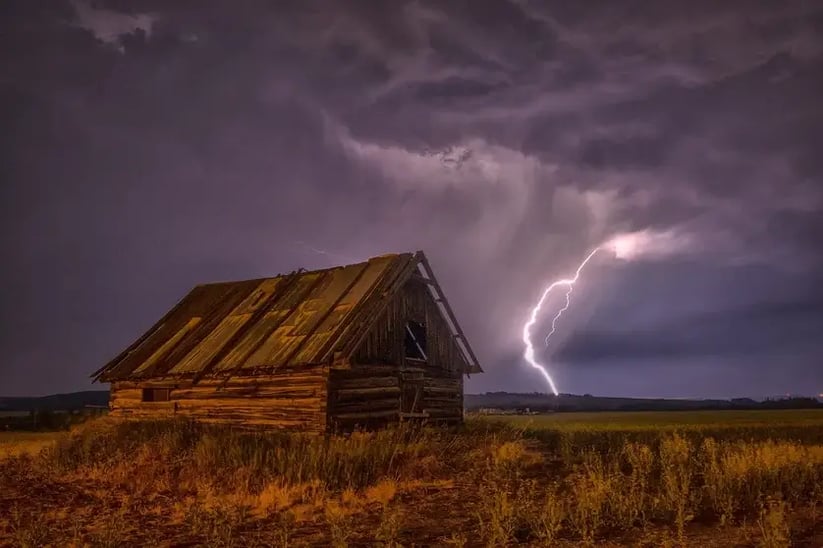
Spring thunderstorms can involve rain, hail, high winds, and lightning, all of which can threaten your roof and home. If your home is struck by lightning, it can sustain significant damage—both visible and hidden from view.
What Is Lightning?
Most lightning is a discharge of static electricity between negatively charged particles in a cloud and positively charged particles on the ground. As air currents and moisture move around during a storm, these opposite charges connect and form a spark, discharging the buildup of energy. Much of that energy is generated as heat: lightning strikes are almost 36,000 degrees Fahrenheit.
Lightning can travel directly from clouds to the ground, but it will tend to take the shortest, easiest route possible. A material that easily conducts electricity is the most attractive path; examples include gas and water pipes, electric lines, phone lines, cable TV or internet lines, gutters, downspouts, and metal window frames. Once the charge finds a conductor, the energy can travel and branch out in its quest to quickly and easily find the ground. It can even jump or “arc” through the air from one conductive path to another, a phenomenon called “side flash.” For example, lightning may first connect to a home’s gutters before arcing to window frames or better grounded water pipes.
Fire Danger
Lightning can cause serious damage if it strikes your home. Because of the high temperatures, any flammable material in and outside of your home puts you at higher risk of fire. Strikes can cause fires directly on contact, while additional materials can ignite when current passes through them and heats them to the point of ignition. If your home has gas piping, lightning strikes may damage valves, regulators, or appliance connectors, causing leakage of flammable gas and subsequent explosions.
Although it seems counterintuitive, a stone-coated steel or metal roof is extremely fire-resistant and can help your home resist lightning damage. If you have a traditional asphalt shingle or wood roof, installing a lightning rod and grounding system can help direct the charge and safely dissipate the current.
Wiring
Lighting that strikes a home’s windows, gutters, or other exterior conductive materials can jump to the electrical system. When a lightning charge travels through electrical wiring, it can cause an explosive surge. This almost certainly will destroy the wires and may cause a fire, as the wires melt and possible ignite the materials surrounding them. The surge can also damage any appliances (particularly electronics like computers and entertainment centers) that are plugged into to the electrical system. Surge protectors can protect against small surges but are unlikely to prevent damage from a direct lightning strike; it is wise to unplug appliances, electronics, and other items during a storm.
If lightning has already struck your home or has been observed in your area, however, avoid any contact with electrical wires or cords. Lightning can travel long distances in both phone and electrical wires, particularly in rural areas. In fact, telephone use is the leading cause of indoor lightning injuries in the United States. If you have a land-line phone, do not use it when there is a threat of lightning strikes.
Water & Pipes
People on or in or near water are among those most at risk for lighting strikes during thunderstorms, both inside and outside the home. Water is a good conductor of electricity, and many homes have metal pipes (themselves fantastic conductors ). Not only can lightning striking your home travel through your pipes but lightning can travel stealthily into your home through shared pipelines that have sustained strikes some distance away from your home. Do not take a bath or shower, wash your hands, do laundry, use an icemaker, or otherwise use running water when there is lightning danger in the area.
Ground Conductivity
Once the visible bolt of lightning has connected the charged air from the clouds to the ground, the current associated with the lightning discharge can travel along the ground for some way before it dissipates enough to be harmless. Many victims of lightning strikes are struck as the current moves in and along the ground. Since lightning current can travel through soil and across moist concrete, wear shoes if walking in a basement, garage, or patio. Most garage floors are especially unsafe because the concrete floors typically contain a wire mesh. In general, very dry basements are a safe place to go during thunderstorms; however, avoid contact with concrete foundation walls, which may contain metal reinforcing bars. As it travels through these surfaces, the current has the potential to ignite flammable materials in and around your home.
Shock Waves
Did you know that the sound of thunder is actually a shock wave, caused by the rapid expansion of heated air around lightning? Since sound travels more slowly than light, it takes longer for you to hear the noise of lighting than to see the bolt of light. Depending on their intensity and proximity, however, the shock waves we call thunder can be extremely destructive, causing structural degradation and cracking in concrete, brick, cinderblock, and stone. Brick and stone chimneys are particularly susceptible to this kind of damage, as the vibrations can damage the mortar and shake loose flashing (potentially allowing water to leak in through the gaps). Thunder shock waves can also fracture objects and create shrapnel, flying debris that can be propelled at a dangerous rate around structures.
If you can hear thunder, you are within 10 miles of a storm—within the strike zone for dangerous lightning. Seek shelter and take precautions as indicated here to avoid being struck. It is safest to wait at least 30 minutes after the last clap of thunder before leaving a protected area.
What to Do If Your House Is Struck by Lightning
If your home or another structure you're in is hit by lightning, check for any fires or scorching, especially in the attic. Use an approved fire extinguisher to put out the flames, if possible, and call the fire department immediately. Fires inside the walls and in the attic spaces can smolder for hours undetected, so consider calling the fire department if your house has been hit even if you don’t see smoke or flames. Especially immediately after a strike, do not touch metal window frames, pipes, or electric cords, and do not use your water. Call emergency services immediately if you see a fire or smell smoke.
Once the storm has passed, assess the damage to your home. To prepare your home before another large storm hits, read through our guide to severe weather.
Contact a professional contractor to schedule a complete inspection of your roof, chimneys, roofing shingles, siding, gutters, and walls for damage. You’ll need to replace or repair shingles, siding, insulation, or windows that have been damaged.







Comments